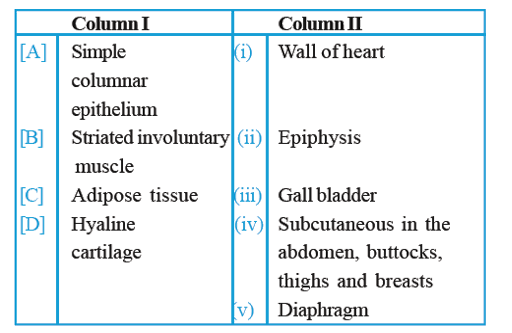Match column I with column II and select the correct option from the codes given below.
Column IColumn IIA. Cleavage(i). FertilisationB. Morula(ii). Mitotic divisionsC. Polyspermy(iii). EndometrialD. Implantation(iv). Little mulberry
A-(ii),B-(iv),C-(i),D-(iii)
A-(i),B-(iv),C-(ii),D-(iii)
A-(iv),B-(ii),C-(i),D-(iii)
A-(ii),B-(iv),C-(iii),D-(i)
The correct Answer is:A
To solve the matching question, we will analyze each term in Column I and find its corresponding term in Column II.
1. Cleavage (A):
- Cleavage refers to the series of mitotic divisions that occur after fertilization. This process results in the formation of smaller cells from the zygote.
- Match: Cleavage (A) matches with Mitotic divisions (ii).
2. Morula (B):
- Morula is the stage of development that occurs after several cleavages, resulting in a solid ball of cells that resembles a mulberry.
- Match: Morula (B) matches with Little mulberry (iv).
3. Polyspermy (C):
- Polyspermy is the phenomenon where an egg is fertilized by more than one sperm. This typically occurs during the fertilization process.
- Match: Polyspermy (C) matches with Fertilization (i).
4. Implantation (D):
- Implantation is the process where the embryo embeds itself into the endometrium, the inner lining of the uterus.
- Match: Implantation (D) matches with Endometrial (iii).
Final Matches:
- A - (ii) Mitotic divisions
- B - (iv) Little mulberry
- C - (i) Fertilization
- D - (iii) Endometrial
Correct Option:
Based on the matches, the correct option is:
- A - (ii)
- B - (iv)
- C - (i)
- D - (iii)
This corresponds to Option 1.
- Cleavage refers to the series of mitotic divisions that occur after fertilization. This process results in the formation of smaller cells from the zygote.
- Match: Cleavage (A) matches with Mitotic divisions (ii).
- Morula is the stage of development that occurs after several cleavages, resulting in a solid ball of cells that resembles a mulberry.
- Match: Morula (B) matches with Little mulberry (iv).
- Polyspermy is the phenomenon where an egg is fertilized by more than one sperm. This typically occurs during the fertilization process.
- Match: Polyspermy (C) matches with Fertilization (i).
- Implantation is the process where the embryo embeds itself into the endometrium, the inner lining of the uterus.
- Match: Implantation (D) matches with Endometrial (iii).
- A - (ii) Mitotic divisions
- B - (iv) Little mulberry
- C - (i) Fertilization
- D - (iii) Endometrial
Based on the matches, the correct option is:
- A - (ii)
- B - (iv)
- C - (i)
- D - (iii)
Similar Questions
Match Column I with Column II and select correct option from the codes given below.
 View Solution
View SolutionMatch column I with Column II and select the correct option from the codes given below
Column IColumn IIA. Pteris(i). BryophyteB. Cedrus(ii). PteridophyteC. Sonchus(iii). GymnospermsD. Marchantia(iv). AngiospermView Solution
Knowledge Check
- Question 1 - Select One
Match column I with II column II and select the correct option from the given codes .
 AA-(ii), B-(iii), C-(iv), D-(i)BA-(iii), B-(ii), C-(i), D-(iv)CA-(iii), B-(ii), C-(iv), D-(i)DA-(i), B-(ii), C-(iii), D-(iv)
AA-(ii), B-(iii), C-(iv), D-(i)BA-(iii), B-(ii), C-(i), D-(iv)CA-(iii), B-(ii), C-(iv), D-(i)DA-(i), B-(ii), C-(iii), D-(iv) - Question 2 - Select One
Mathc column I with column II and select the correct option from the given codes.
 AA-(ii), B-(iii), C-(iv), D-(i), E-(v)BA-(v), B-(iv), C-(iii), D-(i), E-(ii)CA-(i), B-(iii), C-(iv), D-(ii), E-(v)DA-(i), B-(iv), C-(iii), D-(ii), E-(v)
AA-(ii), B-(iii), C-(iv), D-(i), E-(v)BA-(v), B-(iv), C-(iii), D-(i), E-(ii)CA-(i), B-(iii), C-(iv), D-(ii), E-(v)DA-(i), B-(iv), C-(iii), D-(ii), E-(v) - Question 3 - Select One
Mathc column I with column II and select the correct option from the given codes.
 AA-(iii),B-(v), C-(iv),D-(ii)BA-(ii),B-(iv),C-(v),D-(i)CA-(ii),B-(iv),C-(v),D-(iii)DA-(iii), B-(v), C-(iv), D-(i)
AA-(iii),B-(v), C-(iv),D-(ii)BA-(ii),B-(iv),C-(v),D-(i)CA-(ii),B-(iv),C-(v),D-(iii)DA-(iii), B-(v), C-(iv), D-(i)
Match column I with column II and select the correct option from the codes given below
Column IColumn IIA. Psilopsida(i). PsilotumB. Lycopsida(ii). EquisetumC. Sphenopsida(iii). SelaginellaD. Pteropsida(iv). DryopterisView SolutionMatch column I with column II and select the correct option from the codes given below ltBrgt Column IColumn IIA. Uremia(i). Ketone bodies in urineB. Ketonuria(ii). Artificial kidneyC. Glycosuria(iii). Glucose in urineD. Blood dialyser(iv). Accumulation of urea in blood
View SolutionMatch column I with column II and select the correct option from the codes give below.
Column IColumn IISpirogyra(i). UnicellularB. Chlamydomonas(ii). FilamentousC. Volvox(iii). Colonial formD. Some giant marine forms(iv) KelpsView SolutionMath column I with column II and select the correct option from the codes given below
Column IColumn IIA. Food(i). Brown algaeB. Agar(ii). Porphyra, LaminariaC.Algin(iii). Gelidium, GracilariaD. Carrageenin(iv). Red algaeView SolutionMatch column I and II and select the correct option from the given codes.
 View Solution
View Solution

